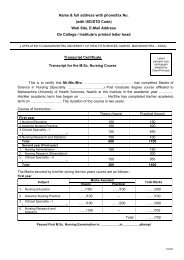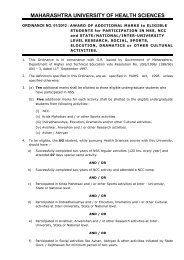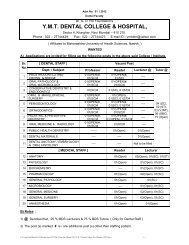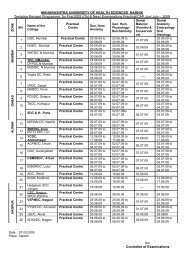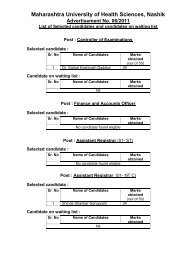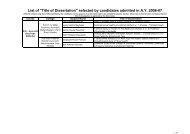Unit I
Unit I
Unit I
Create successful ePaper yourself
Turn your PDF publications into a flip-book with our unique Google optimized e-Paper software.
Compound epithelium: They have two or more layers of cells. They withstand more wear and tear andare chiefly protective in nature. The wear and tear requires constant replenishment of surface cells fromdeeper layers. Such compound epithelia are called ‘Stratified’. According to the type of surface cell theyare further subclassified.Stratified Squamous:There are 5 to 6 layers of cells. The superficial cells are of squamous type. Accordingto the presence or absence of keratin it is further divided into two groups.i) Stratified Squamous Nonkeratinised: The deepest layer consists of a single row of columnar cells. Theintermediate layers show polyhedral cells but as the surface is reached they become flattened so that at thefree surface cells are squamous. Keratin is absent on the surface e.g. mouth, pharynx, oesophagus, vagina,cornea etc.ii) Stratified Squamous Keratinised: The layers from deep to superficial are same as in nonkeratinisedvariety. The superficial cells are dead and hence non-nucleated. They appear as eosinophilic fibrillar strands.This is a tough nonliving layer of keratin e.g. skin.Stratified Cuboidal: It consists usually of only 2-3 layers of epithelial cells in which deeper layers arepolyhedral and superficial layer is cuboidal in shape. e.g. duct of sweat gland, ovarian follicle.Stratified Columnar : It consists of 2-3 layers as in the above variety except for the more superficial cells,which are columnar type. It is present at the transitional zone between different types of epithelia e.g. largeducts of exocrine glands, male urethra, fornix of conjunctiva.Transitional Epithelium: It is also known as urothelium.It is not a transition between two different types ofepithelia. It is a form of stratified epithelium. It is also 5 to 6 layers thick with columnar basal cell layer. Theintermediate cells are pear shaped and the surface cells are umbrella like. Most of the layers show similarcells with rounded nuclei. This similarity of cells differentiates this epithelium from stratified squamousnonkeratinised variety. The base of the epithelium is not indented by connective tissue papillae, thus itpresents an even contour e.g. ureter, urinary bladder.i) Transitional epithelium stretched: Transitional epithelium can be stretched as in full bladder without thesuperficial cells pulling apart from one another. The surface cell have an extra reserve of glycosylatedplates embeded into the cell membrane on the luminal side, which gets stretched out and continues to keepthe epithelium urine-proof.(Hence the other name -Urothelium). They merely become drawn out intobroader thinner cells.ii) Transitional epithelium relaxed: When the transitional epithelium is not stretched, the more superficialcells appear rounded. The surface cells are commonly polyploid or multinucleated.Notes:15





